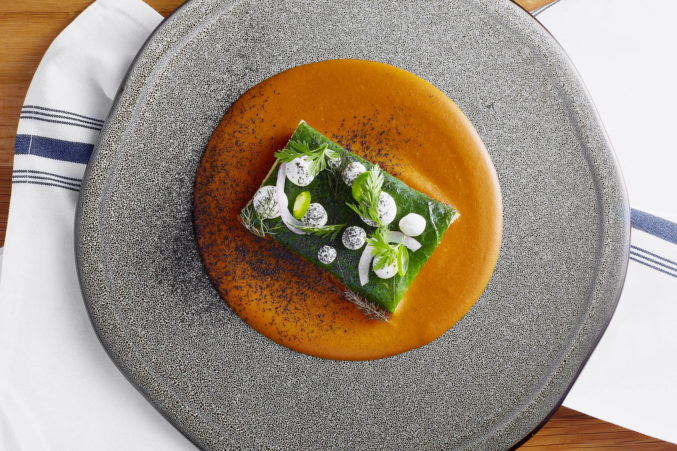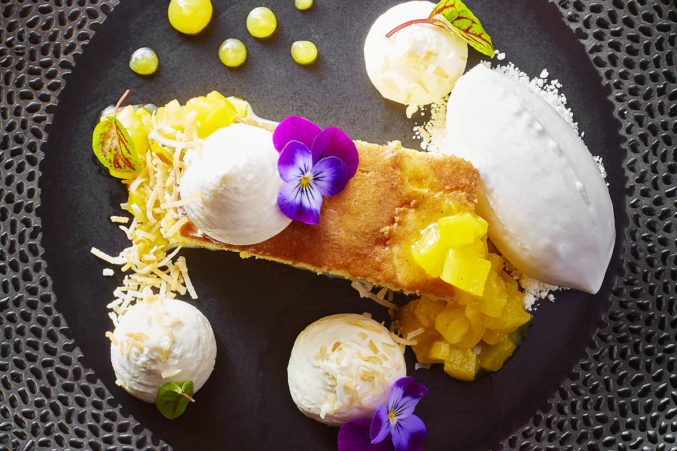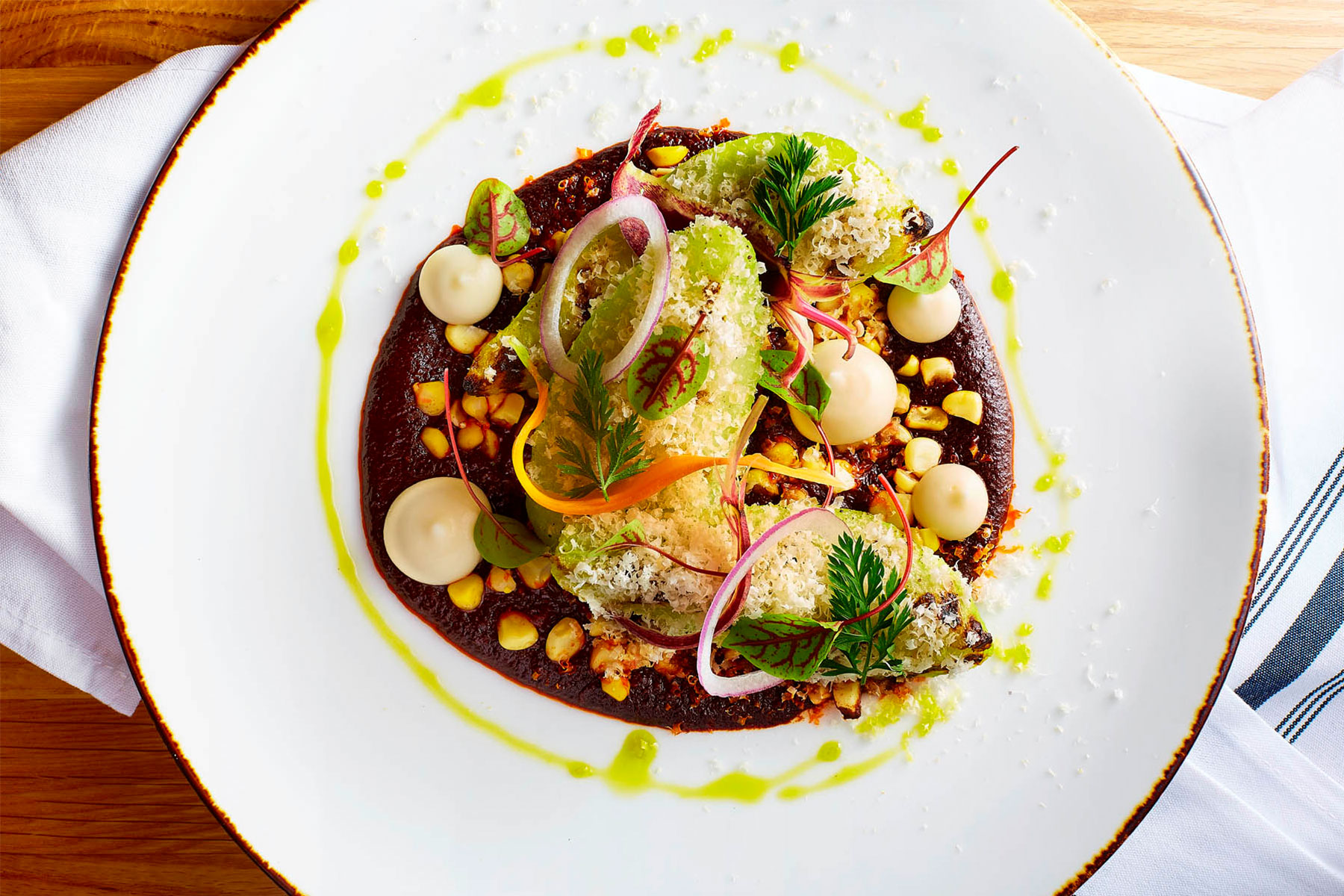Jalisco Norte’s chef, Jose Meza, makes his tamales so they’re smothered rather than filled, flavor immersed in each bite. The elotes tamales have a gossamer veil of cheese sauce and sprinkling of corn kernels. The frijol tamales are wrapped in a fragrant hoja santa leaf and swaddled with a blanket of smooth beans. In these and other dishes, Meza, who studied with two of the world’s finest chefs, can bring Mexican flavors—maize, indigenous herb, bean—into a holy trinity. But he took the long way to get there.
Meza was born in Mexico City, fell into culinary school almost by accident (he dreamed initially of flight school, not copper pots), but once in, chased its arc to the top. He expanded his mind in San Sebastián, Spain; gained confidence working in a two-Michelin-star restaurant in Belgium; and won a coveted position with René Redzepi at Noma in Copenhagen. At Noma, immersed in vapors, aerations, and molecular gastronomy, the master himself asked Meza questions about native Mexican ingredients and techniques that he couldn’t answer. It drove him back to Mexico to learn.
In Copenhagen, Meza met Enrique Olvera, who invited him to work at his famed Mexico City restaurant Pujol, where he married the techniques he’d learned in Europe with tradition. But Mexican food, Meza will tell you, is not a cuisine you can learn in books. It requires going, seeing, and tasting. So he traveled to the Yucatán Peninsula, to Mérida, Oaxaca, Puebla, Tabasco. At Carolina, the signature restaurant at The St. Regis Punta Mita Resort outside Puerto Vallarta, he re-imagined French fine dining as Mexican. That’s where Dean Fearing made Meza’s acquaintance and invited him to cook at our Ritz-Carlton for a chef’s dinner. A friend was looking to open a Mexican restaurant in Dallas, Fearing told him. That is how Meza landed here.

Which is why it pained me to hear, in the first weeks after the flashy Turtle Creek Village opening, that Jalisco Norte’s menu reminded people of Mi Cocina and Javier’s.
It’s true: the space and menu can seem to send mixed messages. Stand by the women hand-making tortillas in the back corner and look out over the sprawling but well-appointed space. You take in a vista of a mask-lined room, the pass’s hand-painted wall, the guava-colored backbar, even the fairy lights that make the enclosed patio feel intimate. (Though there is nothing romantic about the music volume, there or anywhere.) Tucked into the corner of a commercial complex, the buzzy place can seem a singularly inviting spot for skinny margaritas after Pilates or spinning. Drinks have names like Jaliscan on Vacay and Keeping Up With the “Jerry” Joneses.
But if you let the dishes speak to you, you’ll get it: the idea, from famed Pujol and elsewhere, that there is enchantment in indigenous sauces and ingredients, that they can be incorporated into refined cuisine. What we have here is that premise, executed in a casual, inviting way.
Vegetables are given due respect. Nopal salad is a beautiful, modern Mexican composition of tender, green cactus paddle, barely slimy, its herbaceous, mellow cucumber flavor meeting meticulously peeled and diced tomato, laced with chia seeds and brilliant red achiote oil. The house salad is delicately showered in pepitas.
In the vegetarian section, cabbage leaf tacos needed a little warmth and richness, though the accompanying Mayan black recado was interesting. If that cabbage leaf had been more charred, it would have been a better contrast with the many pickled flavors. But not just vegetarians will love the dish with a beautiful chayote at its heart. The quartered squash was still firm, with lovely braised cucumber flavor and a contrasting hazelnut pipian, so thick it gathered in nutty, rich, russet folds.
One evening, two versions of the roasted half chicken allowed us to see the difference between my companion’s, which was fine, and mine, which had clearly been left to dry out under the pass’s heat lamps and was crusty along one side of the breast. Prepared encacahuatado-style, mine married tomato with the warmth and richness of peanut. (I might have rather it had been braised in its embrace.) Hers was robed in a toasted sesame pipian—grainy, like a gravy about to break.
But the sauces are exactly where Meza develops what he knows best. An enchilada plate’s quenelle of refried bean mousse and sprinkle of dehydrated bean powder make it look like a plated dessert. The mole has mad sheen and a flavor that’s soft and rounded from chicken stock. It’s astoundingly complex, with 50 ingredients, the chiles slowly toasted to different thermal points. Still, all it is trying to be is a simple mole enchilada a la carte, from the section titled “Los Familiares”—just plated pretty.
It’s easy to imagine the food in a smaller place, say 70 seats, like the chef was used to (Jalisco has 234). Zoom in to notice the simply prepared branzino’s streak of charred onion ash, one of three ways the fish is prepared. (You can trace your name in it, if you want, while the citrus sauce, like a mojo, carries on a conversation between orange and lemon.) The tidy portion of birria de res’s flavors open up with the beautifully reduced sauce—a magical alchemy with meat that undoes itself at the nudge of a fork. A $4 side of green rice seems to have drunk up cilantro oil.

I don’t think we’ve seen this slow-casual model. Not since Madrina have I seen similar plates, where a pork chop bore a coronet of edible flowers and dessert might come topped with a fragile chocolate cage fashioned in the pastry workshop above. But that was “haute.” Nothing here is trying to be, flying in the face of the adage “Cheap, fast, good—pick two.”
The chocolate dessert has beet purée, a macaron cookie crust, and deep, dark, single-origin-tasting cacao. There’s terroir in that dish. The deconstructed tres leches is electrifying: coconut ice cream chewy with sweetened coconut; meringues of whipped cream topped with crunchy toasted coconut shreds; pansies—yellow, purple, and white; and microgreens. But somehow, clearly, the intent is different. Here, it is grounded in tradition.
I’m still not over my last visit, the night the pastry chef, Carlos Torres, made the maize dessert nicuatole, a corn-based panna cotta like set silk. A pool of atole tasted like guanabana, channeling the mystery of that tropical fruit. The ice cream, too, was satin. Nicuatole is one of a few desserts they serve at Pujol, where it appears in flavor combinations at once simple and dizzying.
Adapting to people’s expectations, Meza says, has not been easy. They want bigger spice, but the authentic style is subtlety. He’s running up against the specter of Tex-Mex and doing it respectfully. “Baby steps,” I wanted to tell him. “We’re getting there.”






